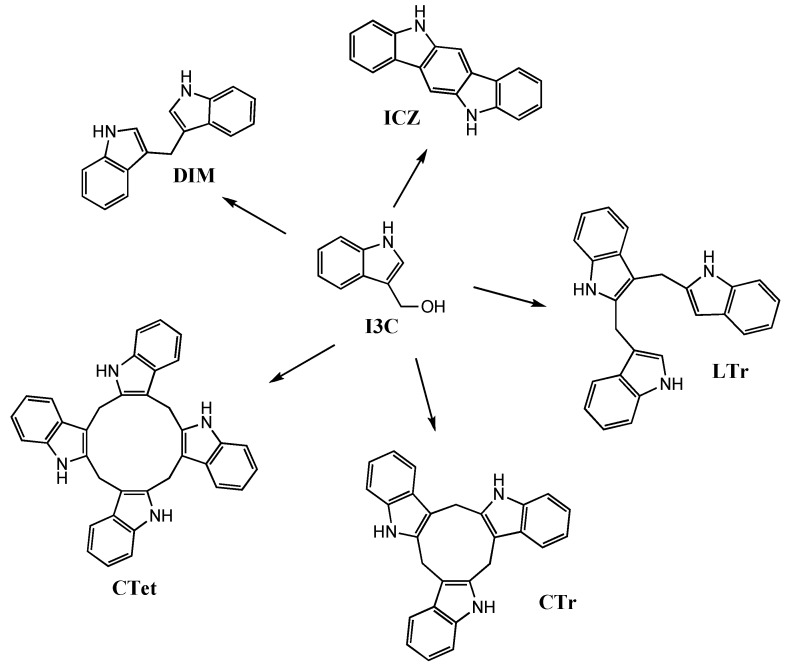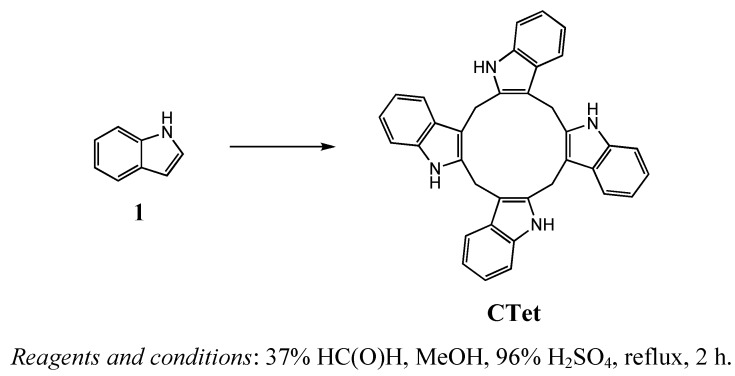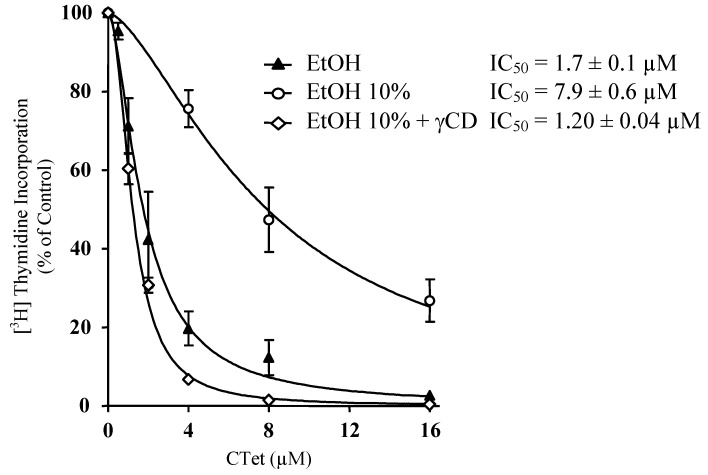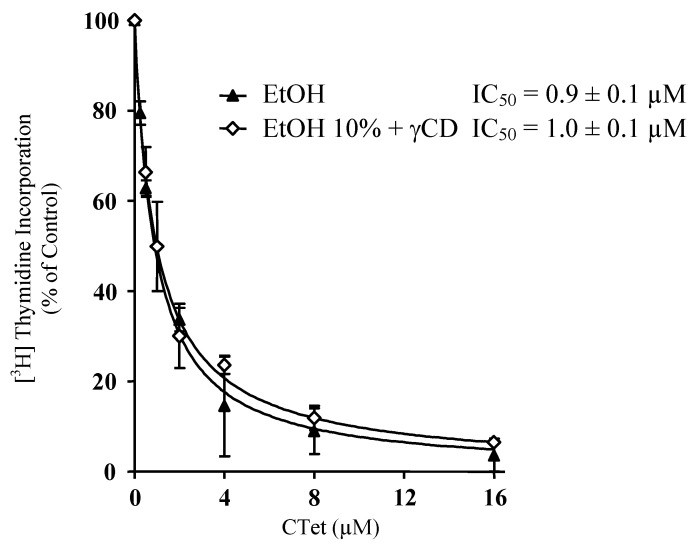Abstract
5,6,11,12,17,18,23,24-octahydrocyclododeca[1,2-b:4,5-b’:7,8-b’’:10,11-b’’’]tetraindole (CTet), an indole-3-carbinol (I3C) metabolite endowed with anticancer properties, is poorly soluble in the solvents most frequently used in biological tests. This study indicates that the use of γ-cyclodextrin (γ-CD) avoids this problem. Formulated with γ-CD CTet is a potent inhibitor of DNA synthesis in both estrogen receptor positive (MCF-7) and estrogen receptor negative (MDA-MB-231) human breast cell lines (IC50 = 1.20 ± 0.04 μM and 1.0 ± 0.1 μM, respectively).
Keywords: indole-3-carbinol, indole cyclic tetramer, γ-cyclodextrin, breast cancer
1. Introduction
Edible cruciferous vegetables of the genus Brassica are endowed with chemopreventive and chemotherapeutic properties [1,2,3]. These actions depend on an autolysis product of 3-indolylmethyl glucosinolate (glucobrassicin), namely indole-3-carbinol (I3C, Figure 1) [4,5], and the resulting indole oligomers produced in the acidic environment of the stomach: 3,3’-diindolylmethane (DIM) [4,5], indolo[3,2-b]carbazole (ICZ) [6,7], the linear trimer LTr [6,8,9], the cyclic trimer CTr [6,8,10], and the cyclic tetramer CTet [11,12] (Figure 1) [2]. The current interest of pharmacologists and medicinal chemists in this topic has resulted in several reports which disclosed synthetic analogues of I3C [13,14,15], DIM [16,17,18,19,20,21,22,23,24,25,26,27,28,29,30,31], and CTr [32] possessing anticancer properties.
Figure 1.
Chemical structures of compounds I3C, DIM, ICZ, LTr, CTr, and CTet.
In order to study the antitumor effects of CTet, we needed a reliable and gram-scale synthesis of this compound. The methods reported in the literature for the preparation of CTet are three. The first involves the one-pot reaction of indole and formaldehyde in acidic methanol, and is in principle advantageous [33]. The second is in fact aimed at obtaining CTr and affords CTet as a by-product in low yield after recrystallization with DMSO; this method, employing gramine as a source in a basic environment of the presumed 3-methylene indolenine intermediate, is practical and efficient but not all its reagents could be utilized on a large scale synthesis because of their toxicity [34]. The third protocol utilizes I3C and acetic acid but the acidic conditions [8] and the purification by means of silica gel column chromatography lead to the formation of polymers and degradation products, so it is not possible to isolate pure CTet by recrystallization with methanol [12].
Unfortunately, CTet is poorly, if at all, soluble in the most common solvents, in particular those usually employed in biological experiments (acetone: 0.04, pyridine: 0.22, 2-butanol: 0.11, DMSO: 0.1% w/v). Furthermore, in chloroform, ethanol, methanol, and toluene CTet solubility is less than 0.1% w/v and the compound is insoluble in water and physiological saline solutions. Several procedures were therefore evaluated to increase CTet solubility in a pharmaceutically acceptable formulation. We found the approach with γ-cyclodextrin (γ-CD) promising, therefore it was selected for further investigation.
2. Results and Discussion
The synthesis of pure CTet was carried out by modifying Bergman et al.’s procedure [33]. When we applied this protocol, we repeatedly obtained results not congruent with the reported ones. In particular, the precipitate that separated from the mixture contained only a trace of the desired CTet, being instead constituted of numerous side-products, probably formed through polymerization processes. However, the filtrate of the reaction mixture did contain CTet, which was isolated by chromatography and recrystallization. In addition, HPLC analysis of the chromatographic fractions showing a single spot on TLC plates demonstrated that CTet was present together with CTr. Bergman’s protocol was modified by prolonging reaction time, due to the presence of the starting material in the mixture after one hour, and by purifying the crude by two rapid passages through short aluminum oxide columns. CTet was finally obtained with a purity higher than 99% by recrystallization from acetone, rather than pyridine [33] and DMSO [34], to facilitate solvent removal. The protocol proved to be scalable, in that it was possible to run it using up to 150 mmol of indole (17.5 g); these experiments gave yields and CTr/CTet ratios comparable with those reported on a lower scale (amounts of reagents higher than those reported were not used) (Scheme 1).
Scheme 1.
Synthesis of 5,6,11,12,17,18,23,24-octahydrocyclododeca[1,2-b:4,5-b’:7,8-b’’:10,11-b’’’]tetraindole (CTet).
With the aim of examining the antiproliferative activity of CTet, the drug was solubilized in pyridine or suspended in ethanol or DMSO and tested on estrogen receptor positive (ER+) breast cancer cell line MCF-7. It resulted that CTet in pyridine could not affect cell proliferation, whereas CTet in DMSO did in a dose-dependent manner (IC50 = 11.3 ± 1.4 µM). Also, CTet suspended in ethanol showed good antiproliferative activity in the same cell line (IC50 = 1.7 ± 0.1 μM) (Figure 2). A pure ethanolic preparation, however, could not be used in clinical studies, thus we considered important to investigate formulations of CTet in an aqueous system.
Figure 2.
Effect of CTet formulated in aqueous solutions on DNA synthesis of MCF-7 breast cancer cell line. Cells were treated with various concentrations of CTet suspended in 10% EtOH (Ο), 10% EtOH with 160 mM γ-CD (◊) or pure EtOH (▲); during the last 5 h of treatment, cells were pulsed with [3H]thymidine, and the incorporation into DNA was determined (1.5 μCi). Data are expressed as percentage of cells treated with vehicle only and are means ± SEM of at least three experiments.
Several protocols such as Solvent Induced Activation (SIA) system with PVP-Cl (polyvinylpyrrolidone-Cl) in different mediums, HP-55 (hydroxypropyl methyl cellulose phthalate), and β- or γ-CD complexation, were investigated. Only γ-CD formulation gave encouraging results. So, while the suspension obtained by diluting the CTet mixture in ethanol/water 1:10 showed a significant loss of biological activity (IC50 = 7.9 ± 0.6 μM; P < 0.001) (Figure 2), when dilution of CTet was carried out in a γ-CD EtOH/H2O (1:10) solution, the activity of CTet resulted superimposable to that of CTet suspended in pure ethanol (IC50 = 1.20 ± 0.04 µM) (Figure 2).
The antiproliferative activities of CTet both suspended in pure ethanol and formulated in γ-CD 10% ethanol were also tested on an estrogen receptor negative (ER-) breast cancer cell line (MDA-MB-231); the results were comparable with those obtained with MCF-7 cells (IC50 = 0.9 ± 0.1 and 1.0 ± 0.1 µM, respectively) (Figure 3). Notably, a 10% ethanolic solution of γ-CD did not have any appreciable cytotoxicity in our tests.
Figure 3.
Effect of CTet formulated in aqueous solutions on DNA synthesis of MDA-MB-231 breast cancer cell line. Cells were treated with various concentrations of CTet suspended in 10% EtOH with 160 mM γ-CD (◊) or pure EtOH (▲); during the last 5 h of treatment cells were pulsed with [3H]thymidine, and the incorporation into DNA was determined (1.5 μCi). Data are expressed as percentage of cells treated with vehicle only and are means ± SEM of at least three experiments. A 10% ethanolic solution of γ-CD did not have any appreciable cytotoxicity in our tests.
Finally, we had ascertained by HPLC that these formulations were stable for many months at room temperature in the dark; this observation is corroborated by the fact that antiproliferative tests in MCF-7 cells were comparable with those reported above (data not shown).
3. Experimental
3.1. General
All reagents were purchased from Sigma-Aldrich or Carlo Erba with the exception of PVP-Cl and HP-55 which were furnished by Eurand, β-cyclodextrin (CAPTISOL®, CyDex), and γ-cyclodextrin (CAVAMAX® W8, Wacker); they were in the highest quality commercially available. Solvents were RP grade. Melting points were determined on a Büchi B-540 capillary melting point apparatus. The structure of CTet was unambiguously assessed by MS, 1H-NMR, and 13C-NMR. MS (ESI) spectra were recorded with a Waters Micromass ZQ spectrometer in a positive mode using a nebulizing nitrogen gas at 400 L/min and a temperature of 250 ºC, cone flow 40 mL/min, capillary 3.5 Kvolts and cone voltage 60 V; only molecular ion in positive ion mode [M+H]+ is given. Retention time (tR) value was determined by direct HPLC analysis by Waters 2795 Separations Module, Alliance HT and Waters 2996, Photodiode Array Detector spectrometers with a SupelcosilTM LC-18 (15 cm × 4 mm, 3 μM; Supelco) column using a combination of acetonitrile and aqueous solution 0.1% formic acid as eluent. 1H-NMR and 13C-NMR spectra were recorded on a Bruker AC 200 or 50, instrument, respectively, and analyzed using the WIN-NMR software package. Chemical shifts were measured by using the central peak of the solvent. Purification of the crude material was carried out by column chromatography on aluminum oxide (0.05–0.15 mm, Fluka). TLC analyses were performed on precoated aluminum oxide on aluminum sheets (60 F254, neutral; Merck).
3.2. Synthesis of 5,6,11,12,17,18,23,24-octahydrocyclododeca[1,2-b:4,5-b’:7,8-b’’:10,11-b’’’]tetraindole (CTet)
To a solution of indole (3.12 g, 26.7 mmol) and aqueous 37% HC(O)H (3.2 mL, 40 mmol) in CH3OH (240 mL), 96% H2SO4 (1.74 mL) was added. The mixture was stirred at reflux in the dark for 1 h, then further HC(O)H (3.2 mL, 40 mmol) was added, the mixture was stirred in the same conditions for 1 h, cooled to room temperature and concentrated in the dark. Purification of the solid by two short, protected from light, and fast aluminum oxide column chromatographies (cyclohexane/EtOAc 6:4, Rf = 0.82) and washing with hot CH3OH gave a white solid consisting (HPLC/MS) in a 9:1 mixture of CTr and CTet [HPLC: SupelcosilTM LC-18; flow: 0.5 mL/min; λmax: 284 nm; eluent: CH3CN/aqueous solution 0.1% HCOOH with a gradient 7:3 to 9:1 in 9 min; tR CTr: 4.95 min, tR CTr: 6.93 min]. Yield: 31% (1.08 g). Recrystallization [(CH3)2CO, 78 mL] afforded pure CTet as a white solid. Mp: chars over 300 ºC. MS (ESI) m/z: 517.2 [M+H]+. 1H-NMR [(CD3) 2CO]: δ3.88 (s, 8H, CH2), 6.85 (dd, 4H, ArH, J1 = 7.0 and J2 = 8.0 Hz), 6.99 (dd, 4H, ArH, J1 = 7.0 and J2 = 8.0 Hz), 7.24 (d, 4H, ArH, J = 8.0 Hz), 7.33 (d, 4H, ArH, J = 8.0 Hz), 9.95 (s, 4H, NH); 13C-NMR (pyridine-d5): δ 23.6, 109.1, 112.6, 119.4, 120.4, 122.0, 131.4, 137.7, 138.0.
3.3. CTet formulations
A suspension of CTet (0.0083 g, 0.016 mmol) in pure EtOH (1 mL) was magnetically stirred at room temperature for different times (1 to 3 days, 1,000 rpm). The highest percentage of inhibition was obtained when the suspension was stirred for at least 2 days. This time was routinely used in all further experiments. The emulsion obtained was then diluted (volume ratio 1:10) by an aqueous solution of γ-CD (177 mM); the resulting white emulsion had a final concentration of 1.6 mM. The antiproliferative assays were performed with 10 μL of formulated product appropriately diluted in 1 mL of the cellular culture medium.
3.4. Cell cultures and antiproliferative assay
The human breast carcinoma ER+ (MCF-7) and ER- (MDA-MB-231) cell lines were cultured in DMEM (Dulbecco’s Modified Eagle’s Medium) supplemented with 10% FCS (Fetal Calf Serum), 2 mM L-glutamine, 10 g/L NEAA (Non-Essential Amino Acid), 50 mg/L streptomycin, 1,000 U/L penicillin, with (in the case of MCF-7) or without (in the case of MDA-MB-231) 10 mg/L insulin. Cells (30,000/well in 24-well tissue culture plates) were treated with the several CTet formulations or respective vehicles for 72 h, and during the last 4 h of treatment were pulsed with 1.5 μCi of [3H]thymidine and processed [12].
3.5. Statistical analyses
Data are means ± SEM of at least three separate experiments. Differences between means were evaluated by Student t-test; differences were considered significant at P < 0.05 (Prism5, GraphPad Software Inc., La Jolla, CA, USA).
4. Conclusions
A straightforward, reproducible, and scalable synthesis of CTet is reported, together with a formulation of CTet that allows the molecule to exert its pharmacological potential as an inhibitor of DNA synthesis in both ER+ and ER- human breast cancer cells. It is hypothesized that γ-CD is capable to enhance the otherwise very low solubility of the drug in aqueous systems.
Acknowledgements
The authors thank Giorgio Tarzia for his helpful hints.
Footnotes
Sample Availability: A sample of the compound is available from the authors.
References
- 1.Peter F.M., editor. National Research Council. Diet, Nutrition and Cancer. National Academy Press; Washington, DC, USA: 1982. pp. 358–370. [Google Scholar]
- 2.Weng J.-R., Tsai C.-H., Kulp S.K., Chen C.-S. Indole-3-carbinol as a chemopreventive and anti-cancer agent. Cancer Lett. 2008;269:153–163. doi: 10.1016/j.canlet.2008.01.033. [DOI] [PMC free article] [PubMed] [Google Scholar]
- 3.Safe S., Papineni S., Chintharlapalli S. Cancer chemotherapy with indole-3-carbinol, bis(3’-indolyl)methane and synthetic analogs. Cancer Lett. 2008;269:326–338. doi: 10.1016/j.canlet.2008.04.021. [DOI] [PMC free article] [PubMed] [Google Scholar]
- 4.Virtanen A.I. Studies on organic sulphur compounds and other labile substances in plants. Pythochemistry. 1965;4:207–228. doi: 10.1016/S0031-9422(00)86168-3. [DOI] [PubMed] [Google Scholar]
- 5.Wattenberg L.W., Loub W.D. Inhibition of polycyclic aromatic hydrocarbon-induced neoplasia by naturally occurring indoles. Cancer Res. 1978;38:1410–1413. [PubMed] [Google Scholar]
- 6.Bjeldanes L.F., Kim J.-Y., Grose K.R., Bartholomew J.C., Bradfield C.A. Aromatic hydrocarbon responsiveness-receptor agonists generated from indole-3-carbinol in vitro and in vivo: Comparisons with 2,3,7,8-tetrachlorodibenzo-p-dioxin. Proc. Natl. Acad. Sci. USA. 1991;88:9543–9547. doi: 10.1073/pnas.88.21.9543. [DOI] [PMC free article] [PubMed] [Google Scholar]
- 7.D'Argy R., Bergman J., Dencker L. Effects of immunosuppressive chemicals on lymphoid development in fetal thymus organ cultures. Pharmacol. Toxicol. 1989;64:33–38. doi: 10.1111/j.1600-0773.1989.tb00596.x. [DOI] [PubMed] [Google Scholar]
- 8.De Kruif C.A., Marsman J.W., Venekamp J.C., Falke H.E., Noordhoek J., Blaauboer B.J., Wortelboer H.M. Structure elucidation of acid reaction products of indole-3-carbinol: detection in vivo and enzyme induction in vitro. Chem.-Biol. Interact. 1991;80:303–315. doi: 10.1016/0009-2797(91)90090-t. [DOI] [PubMed] [Google Scholar]
- 9.Chang Y.-C., Riby J., Chang G.H.-F., Peng B.C., Firestone G., Bjeldanes L.F. Cytostatic and antiestrogenic effects of 2-(indol-3-ylmethyl)-3,3’-diindolylmethane, a major in vivo product of dietary indole-3-carbinol. Biochem. Pharmacol. 1999;58:825–834. doi: 10.1016/s0006-2952(99)00165-3. [DOI] [PubMed] [Google Scholar]
- 10.Riby J.E., Feng C., Chang Y.-C., Schaldach C.M., Firestone G.L., Bjeldanes L.F. The major cyclic trimeric product of indole-3-carbinol is a strong agonist of the estrogen receptor signaling pathway. Biochemistry. 2000;39:910–918. doi: 10.1021/bi9919706. [DOI] [PubMed] [Google Scholar]
- 11.Grose K.R., Bjeldanes L.F. Oligomerization of indole-3-carbinol in aqueous acid. Chem. Res. Toxicol. 1992;5:188–193. doi: 10.1021/tx00026a007. [DOI] [PubMed] [Google Scholar]
- 12.Brandi G., Paiardini M., Cervasi B., Fiorucci C., Filippone P., De Marco C., Zaffaroni N., Magnani M. A new indole-3-carbinol tetrameric derivative inhibits cyclin-dependent kinase 6 expression, and induces G1 cell cycle arrest in both estrogen-dependent and estrogen-independent breast cancer cell lines. Cancer Res. 2003;63:4028–4036. [PubMed] [Google Scholar]
- 13.Weng J.-R., Tsai C.-H., Kulp S.K., Wang D., Lin C.-H., Yang H.-C., Ma Y., Sargeant A., Chiu C.-F., Tsai M.-H., Chen C.-S. A potent indole-3-carbinol–derived antitumor agent with pleiotropic effects on multiple signaling patways in prostate cancer cells. Cancer Res. 2007;67:7815–7824. doi: 10.1158/0008-5472.CAN-07-0794. [DOI] [PubMed] [Google Scholar]
- 14.Jump S.M., Kung J., Staub R., Kinset M.A., Cram E.J., Yudina L.N., Preobrazhenskaya M.N., Bjeldanes L.F., Firestone G.L. N-Alkoxy derivatization of indole-3-carbinol increases the efficacy of the G1 cell cycle arrest and of I3C-specific regulation of cell cycle gene transcription and activity in human breast cancer cells. Biochem. Pharmacol. 2008;75:713–724. doi: 10.1016/j.bcp.2007.09.024. [DOI] [PMC free article] [PubMed] [Google Scholar]
- 15.Guo W., Wu S., Liu J., Fang B. Identification of a small molecule with synthetic lethality for K-Ras and protein kinase C iota. Cancer Res. 2008;68:7403–7408. doi: 10.1158/0008-5472.CAN-08-1449. [DOI] [PMC free article] [PubMed] [Google Scholar]
- 16.Ramamoorthy K., Navo M., Gupta M.S., Safe S.H. AhR-mediated antiestrogenicity of diindolylmethane and analogs in vivo and in vitro. Organohalogen Compd. 1998;37:321–324. [Google Scholar]
- 17.Ramamoorthy K., McDougal A., Safe S.H. Structure-Ah receptor agonist/binding activity relationships of various chlorine-substituted diindolylmethane compounds. Organohalogen Compd. 1999;42:363–367. [Google Scholar]
- 18.McDougal A., Gupta M.S., Ramamoorthy K., Sun G., Safe S.H. Inhibition of carcinogen-induced rat mammary tumor growth and other estrogen-dependent responses by symmetrical dihalo-substituted analogs of diindolylmethane. Cancer Lett. 2000;151:169–179. doi: 10.1016/S0304-3835(99)00406-1. [DOI] [PubMed] [Google Scholar]
- 19.McDougal A., Gupta M.S., Morrow D., Ramamoorthy K., Lee J.-E., Safe S.H. Methyl-substituted diindolylmethanes as inhibitors of estrogen-induced growth of T47D cells and mammary tumors in rats. Breast Cancer Res. Treat. 2001;66:147–157. doi: 10.1023/A:1010608000074. [DOI] [PubMed] [Google Scholar]
- 20.Benabadji S.H., Wen R., Zheng J.-B., Dong X.-C., Yuan S.-G. Anticarcinogenic and antioxidant activity of diindolylmethane derivatives. Acta Pharmacol.Sin. 2004;25:666–671. [PubMed] [Google Scholar]
- 21.Pisano C., Kollar P., Gianní M., Kalac Y., Giordano V., Ferrara F.F., Tancredi R., Devoto A., Rinaldi A., Rambaldi A., Penco S., Marzi M., Moretti G., Vesci L., Tinti O., Carminati P., Terao M., Garattini E. Bis-indols: a novel class of molecules enhancing the cytodifferentiating properties of retinoids in myeloid leukemia cells. Blood. 2002;100:3719–3730. doi: 10.1182/blood-2002-03-0720. [DOI] [PubMed] [Google Scholar]
- 22.Giannini G., Marzi M., Moretti G.P., Penco S., Tinti M.O., Pesci S., Lazzaro F., De Angelis F. Synthesis of cycloalkanoindoles by an unusual DAST-triggered rearrangement reaction. Eur. J. Org. Chem. 2004:2411–2420. [Google Scholar]
- 23.Maciejewska D., Rasztawicka M., Wolska I., Anuszewka E., Gruber B. Novel 3,3’-diindolylmethane derivatives: Synthesis and cytotoxicity, structural characterization in solid state. Eur. J. Med. Chem. 2009;44:4136–4147. doi: 10.1016/j.ejmech.2009.05.011. [DOI] [PubMed] [Google Scholar]
- 24.Sanderson J.T., Slobbe L., Lansbergen G.W.A., Safe S., van der Berg M. 2,3,7,8-Tetrachlorodibenzo-p-dioxin and diindolylmethanes differentially induce cytochrome P450 1A1, 1B1, and 19 in H295R human adrenocortical carcinoma cells. Toxicol. Sci. 2001;61:40–48. doi: 10.1093/toxsci/61.1.40. [DOI] [PubMed] [Google Scholar]
- 25.Qin C., Morrow D., Stewart J., Spencer K., Porter W., Smith R., III, Phillips T., Abdelrahim M., Samudio I., Safe S. A new class of peroxisome proliferator-activated receptor g (PPARg) agonists that inhibit growth of breast cancer cells: 1,1-Bis(3’-indolyl)-1-(p-substituted phenyl)methanes. Mol. Cancer Ther. 2004;3:247–259. [PubMed] [Google Scholar]
- 26.Contractor R., Samudio I.J., Estrov Z., Harris D., McCubrey J.A., Safe S.H., Andreeff M., Konopleva M. A novel ring-substituted diindolylmethane, 1,1-bis[3’-(5-methoxyindolyl)]-1-(p-t-butylphenyl) methane, inhibits extracellular signal-regulated kinase activation and induces apoptosis in acute myelogenous leucemia. Cancer Res. 2005;65:2890–2898. doi: 10.1158/0008-5472.CAN-04-3781. [DOI] [PubMed] [Google Scholar]
- 27.Chintharlapalli S., Burghardt R., Papineni S., Ramaiah S., Yoon K., Safe S. Activation of Nur77 by selected 1,1-bis(3’-indolyl)-1-(p-substitued phenyl)methanes induces apoptosis through nuclear pathways. J. Biol. Chem. 2005;280:24903–24914. doi: 10.1074/jbc.M500107200. [DOI] [PubMed] [Google Scholar]
- 28.Inamoto T., Papineni S., Chintharlapalli S., Cho S.-D., Safe S., Kamat A.M. 1,1-Bis(3’-indolyl)-1-(p-chlorophenyl)methane activates the orphan nuclear receptor Nurr1 and inhibits bladder cancer growth. Mol. Cancer Ther. 2008;7:3825–3833. doi: 10.1158/1535-7163.MCT-08-0730. [DOI] [PMC free article] [PubMed] [Google Scholar]
- 29.Noguchi-Yachide T., Tetsuhashi M., Aoyama H., Hashimoto Y. Enhancement of chemically-induced HL-60 cell differentiation by 3,3’-diindolylmethane derivatives. Chem. Pharm. Bull. 2009;57:536–540. doi: 10.1248/cpb.57.536. [DOI] [PubMed] [Google Scholar]
- 30.Chao W.-R., Yean D., Amin K., Green C., Jong L. Computer-aided rational drug design: A novel agent (SR13668) designed to mimic the unique anticancer mechanisms of dietary indole-3-carbinol to block akt signaling. J. Med. Chem. 2007;50:3412–3415. doi: 10.1021/jm070040e. [DOI] [PubMed] [Google Scholar]
- 31.Vincent E., Shirani H., Bergman J., Rannug U., Janosik T. Synthesis and biological evaluation of fused thio- and selenopyrans as new indolocarbazole analogues with aryl hydrocarbon receptor affinity. Bioorg. Med. Chem. 2009;17:1648–1653. doi: 10.1016/j.bmc.2008.12.072. [DOI] [PubMed] [Google Scholar]
- 32.Xue L., Schaldach C.M., Janosik T., Bergman J., Bjeldanes L.F. Effects of analogs of indole-3-carbinol cyclic trimerization product in human breast cancer cells. Chem.-Biol. Interact. 2005;152:119–129. doi: 10.1016/j.cbi.2005.02.007. [DOI] [PubMed] [Google Scholar]
- 33.Bergman J., Högberg S., Lindström J.-O. Macrocyclic condensation products of indole and simple aldehydes. Tetrahedron. 1970;26:3347–3352. doi: 10.1016/S0040-4020(01)92912-6. [DOI] [Google Scholar]
- 34.Staub R.E., Bjeldanes L.F. Convenient synthesis of 5,6,11,12,17,18-hexahydrocyclononal[1,2-b:4,5-b’:7,8-b’’]triindole, a novel phytoestrogen. J. Org. Chem. 2003;68:167–169. doi: 10.1021/jo020415y. [DOI] [PubMed] [Google Scholar]






